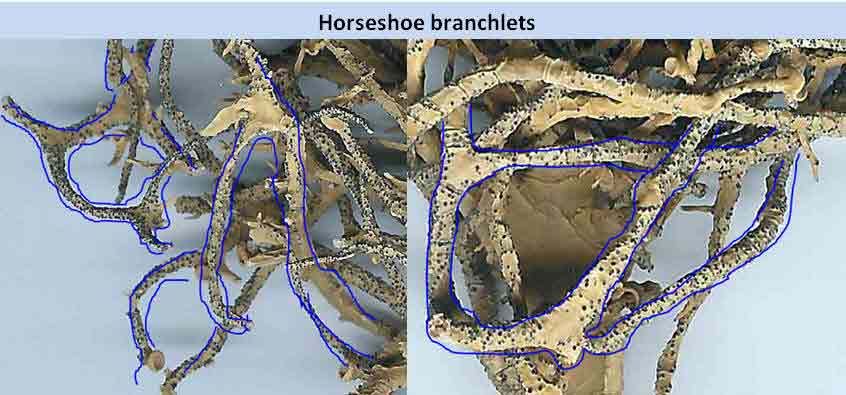|
Niebla and Vermilacinia (Ramalinaceae) from California and Baja
California.
|
|
 |
©The
World Botanical Associates Web Page
Prepared by Richard W. Spjut
April 2003. Comments added Oct 2005, Sep 2012,, Dec 2021
|
Niebla and Vermilacinia (Ramalinaceae) from California and Baja
California.
|
|
 |
|
Niebla marinii is a species of fruticose lichen endemic to Baja California. It occurs along the Pacific Coast in the Northern Vizcaíno Desert from Morro Santo Domingo north to San Fernando Canyon, and possibly further north to the peninsula southwest of San Quintín. It is recognized by having salazinic-acid and by its wide spreading-arcuate isodichotmous branches that terminally appear as horseshoe, horse tail or whip like branchlets when pressed; however, the three dimensional shape is much like a wiffle ball. The cortex is glazed and glossy from which pycnidia appear sharply defined and conspicuously abundant on the terminal branchlets. Apothecia occur in >90% of the thalli, and often are abundant, usually disciform in shape associated with a reflexed branchlet. Niebla marinii was abundant at the type locality on red volcanic rocks. The thalli were all remarkably similar in their morphology as well as their chemistry, unlike Niebla communities at other locations. However, this may be due to relatively recent establishment of a Niebla community at this location. Associated species included N. lobulata (sekikaic acid), N. flabellata (salazinic acid), N. undulata (divaricatic acid), N. siphonoloba (sekikaic acid) and Roccella fimbriata. Specimens from Punta Cono have a more prominent reticulately ridged cortex, but are considered N. marinii by the characteristic pattern of isodichotomous whip-like branches Specimens from Mesa Camacho have sharply prismatic branches with prominent transverse cortical ridges between the angular margins, distinctive features worthy of taxonomic status; hence, the proposed name, Niebla angulata (Spjut ined.). The closely related Niebla josecuervoi (salazinic acid) differs by the more sharply defined secondary branchlets along the upper side of a main branch. Its main branches are more rigid, generally straight to geniculate (abruptly bent), not whip-like; its cortex is usually dull with more sharply defined ridges. Other species of Niebla with whip-like branches differ by their chemical constituents; these include N suffnessii (sekikaic acid) and N. juncosa var. juncosa (divaricatic acid) at the Morro Santo Domingo location where also rare, occurring on sand under bushes, not on lava. Phylogenetic studies do not clearly support the species (Spjut et al. 2021); however, Jorna et al. (2021) show the species distinct in their phylogenetic tree of the salazinic acid and sekikaic acid clades based on a BPP analysis recognizing nine depsidone species. Niebla angulata Spjut (ineditus) is distinct for having salazinic acid and sharply angled branchlets. It appears endemic to Mesa Camacho along with the sekikaic acid N. sinuata Spjut (ineditus). Additional References: See Niebla. |